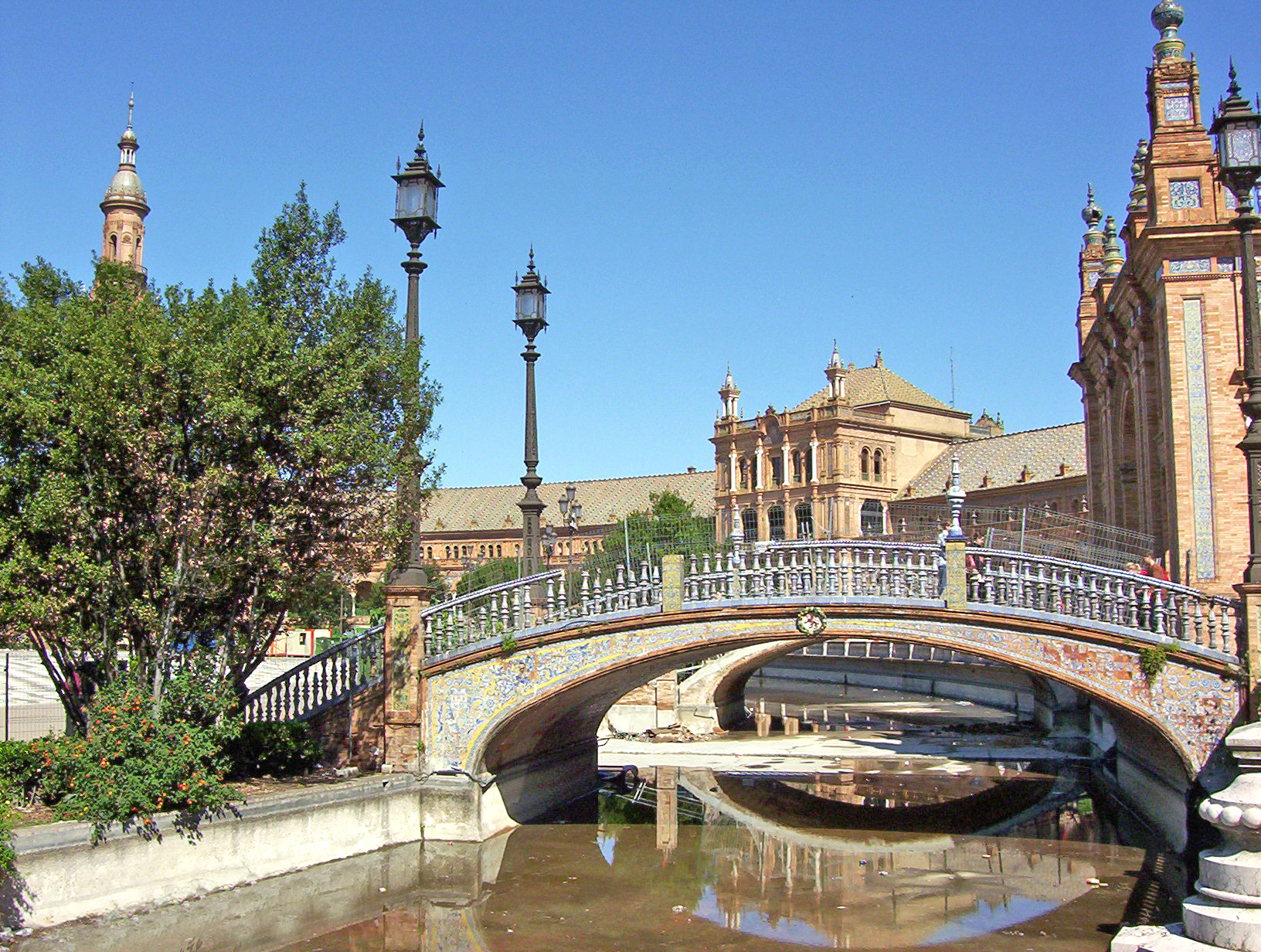Seville, the capital of the Andalusia autonomous community, lies in the Guadalquivir valley. Because of its mild climate (mainly Mediterranean with Oceanic influences), Seville’s Winters are cool, Springs and Falls enjoy quite pleasant temperatures whereas Summers are very hot.
With its 702.000 inhabitants, Seville is the fourth most populated city in Spain after Madrid, Barcelona and Valencia.
Seville is also the capital of the Seville province that boasts 1.714.000 inhabitants on its 14.0001 km2.
History
The Legends tells that Seville was founded by Hercules. But according to historians, the Seville area flourished during the Tharsis reign. The Phoenicians and Greeks maintained commercial relations with Tharsis. During the 8th century BC, their descendants created a city on the shores of the Guadalquivir and named it Ispal. It would be later called Hispalis and is considered to be the origin of Seville.
From the 3rd century BC, the Carthaginians occupied the area but they were defeated by the Roman, Scipio Africanus in 206 BC. From then on, Seville entered into an age of splendor. This was even truer when Julius Caesar gave Seville the status of colony in 45 BC. The surprising fact is that, nowadays, there is little rest of this flourishing roman period.
During that period, various invasions took place, particularly Vandals and Visigoths. The latter dominated Seville during the 6th and 7th centuries. This is when Seville became the most important cultural area in the Occident. The great figure of that time was the archbishop San Isidoro, who wrote Etymologies, the encyclopedia gathering all the knowledge of those days.
In 712 started the domination of the Arabs over Sevilla, that they called at that time Isbiliah. The Betis river was also renamed Guad el Kevir. Those two names are the origin of the current names of Seville and Guadalquivir river. Under the Arab ruling, Seville entered into another age of splendor. When the Almohades arrived in 1147, they transferred the center of the power from Cordoba to Seville and made it their capital. From this last period of the Arab-Andalusian domination remain the Giralda, the Torre del Oro, the Alcazar (later rebuilt by the Christian kings) and the Macarena wall (Muralla de la Macarena).
In 1248, Ferdinand III The Saint conquested Seville for Christianity. Muslims were forced to leave whereas Mudejars and Hebrews stayed. Seville was repopulated with some 24.000 Castilians who grouped together in different neighborhoods according to their occupations. This led to the creation of brotherhoods that still exist nowadays and to the attribution of patron saints for each.
A lot of churches were built to replace the mosques. Ferdinand III transferred the Kingdom of Castile Court to the Alcazar of Seville. He stayed there until he died in 1252 and is considered as Seville’s patron saint.
Ferdinand III’s son, Alfonso X, continued his father’s work. He established a tolerant reign which enabled the Jewish, Arab and Christian’s knowledge to boom.
Under Peter I of Castile (1350-69), the city grew in an extraordinary way. The Alcazar was rebuilt and transformed in a beautiful mudejar palace.
In 1401, the Gothic-style Cathedral was built over the Big Mosque. However the Giralda as well as the patio de los naranjos (Orange trees courtyard) were kept.
The overtaking of Granada in 1492 marked the end of the Reconquest process; the Jews were expelled and Seville became the headquarters of the Inquisition. In 1492 Christopher Columbus discovered America. From then on, Seville experienced its apogee. Indeed, the Chamber of Commerce was created to deal with the trade relations between Spain and the overseas territories.
The new American market as well as the monopoly of Seville on the trade relations brought it much wealth. Seville became the wealthiest city of Spain as well as the most cosmopolitan.
In 1519, Carlos I of Spain (Carlos V of Germany) became emperor. Spain became the most powerful nation in Europe, although the constant wars of the empire ruined a big part of the wealth coming to the port.
The territory of the city expanded and the population grew up to 150.000 inhabitants at the end of 15th century. Three famous painters actually were born in Seville at that time: Velazquez (1599), Murillo (1617) and Valdes Leal (1622).
Nonetheless, the 17th century saw the decline of Seville. After a plague epidemic in 1649 divided the population by two, the Guadalquivir got stuck in 1680. The India fleet was moved to Cadix, soon followed by the whole Chamber of Commerce. Seville however kept its monopoly on tobacco and a huge plant was built to this end. Nowadays, this plant houses Seville’s university.
After the Independence war and another plague epidemic in the 19th century, Seville experienced another period of prosperity under Queen Elisabeth, who implemented urban reforms, in particular the construction of the Elisabeth II bridge (Puente Isabel II) in 1845 and the collapse of the wall around the city in 1869, which gave birth to new roads and squares.
During the 20th century, Seville hosted two expositions that modified its landscapes. In 1929, Seville welcome the Latin-American exposition, the aim of which was to strengthen the Andalusian economy. Several houses representing various countries were built for this exposition and still exist nowadays. 63 years later, in 1992, Seville hosted another big exposition: the Universal Exposition.
Places of interest
- Plaza de la Virgen de los Reyes and Plaza del Triunfo
- Plaza de España
- La Giralda and the Catedral
- The Alcazar
- Barrio de Santa Cruz (Santa Cruz neighborhood)
- The Torre del Oro
- María Luisa Park
- The Paseo de las Delicias
- Triana
- Cartuja Island
Festivities
- Holy Week
- Feria de Abril (April feria)
- Romería del Rocío (Pentecost)



